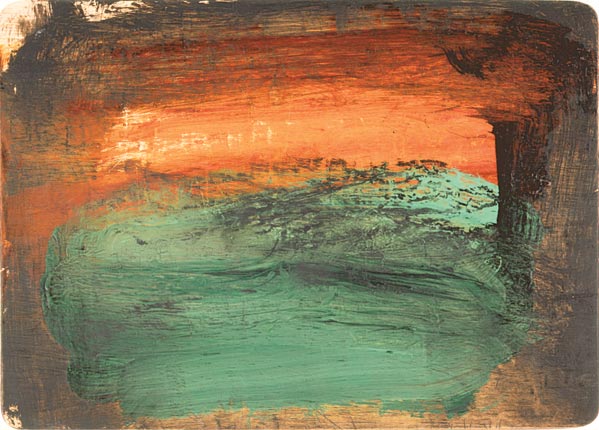Howard Hodgkin: Time and Place, Modern Art, Oxford

Does a decade of new work from the abstract painter Howard Hodgkin, who is currently climbing up the hill towards his ninth decade, reveal a different kind of an artist? Yes and no. Much hangs – as it has always done – upon the titles of these 25 new works. Hodgkin's titles have always been something of a tease. They have seemed to be leading us somewhere quite precise. They have often suggested intimate domestic moments with friends or lovers. People and places have been named as if we were being introduced to something baldly – or perhaps even boldly – descriptive.
Not a bit of it. Or perhaps, if you looked hard enough, you could find just a teeny bit of it, the hint of a human shape, the curve of an elbow. Mostly though with Hodgkin we have become accustomed to ferociously smeary symphonic archings of pure colour, all clashing together or mounting or overlapping each other – yes, the enterprise has often looked quite feverishly sexy – with cymbalic fervour, often set inside kitschy, over-elaborate, thrift-shop frames, with the paint engorging those frames like an over-hungry tongue eager to get to the bottom of the cone.
There are some differences this time though. These days, the paintings often look faster in the making and coarser-grained than usual, more violently gestural, as if he has thrown off an inhibition or two. Why should not old men be mad? They differ wildly in size, from the tiny to some of the largest he has ever made. There seems to be no particular reason for this. The big ones could just as easily be small, we feel, and the small bigger than they have ended up as being. This is the first show of work in Modern Art's refurbished space, and it has left us with four galleries of oddly different sizes and shapes. With some painters, this would matter. The work and the spaces would look oddly mismatched. Hodgkin's work looks quite happy here, almost on holiday. Its oddities accommodate the gallery's.
Hodgkin has exchanged the inexactitudes of the domestic for the inexactitudes of nature. He seems to be more out in the world these days, looking and taking deep breaths beside the likes of Samuel Palmer or that glorious 19th-century American eccentric Albert Pinkham Ryder. His titles no longer have touches of society sophistication. They use plainsman's words: Mud, Dirty Weather, Leaf, Snake. And when we look at Dirty Weather, we do indeed see that it is, in part at least, a fairly straightforward rendering of what could easily be filthy skies, drizzle and foot-sloggingly muddy fields. There is a plain of dense green horizontals smudged with black, what could be elements of a wood rearing up to left and to right, the hint of the promise of light breaking through clouds, and a densely oppressive brown overlayering it all, pressing down, mightily oppressing us, rather in the way that the English weather is accustomed to oppressing us. Yes, we English rather feel at home in this painting. We feel a chill coming on even as we stare at it. Hodgkin is an abstract man, always has been, but perhaps he is less rarefied than he seems. Perhaps he knows how we feel – even though he dropped out of Eton.
To 5 September (01865 722 733)
Subscribe to Independent Premium to bookmark this article
Want to bookmark your favourite articles and stories to read or reference later? Start your Independent Premium subscription today.

Join our commenting forum
Join thought-provoking conversations, follow other Independent readers and see their replies